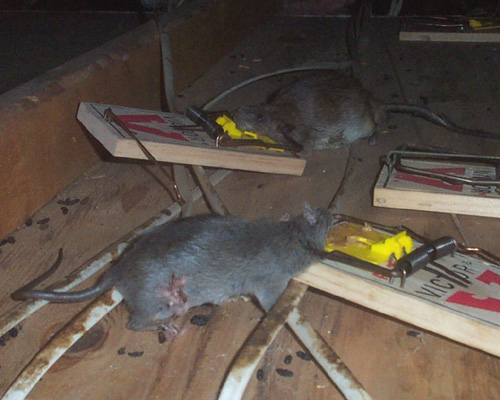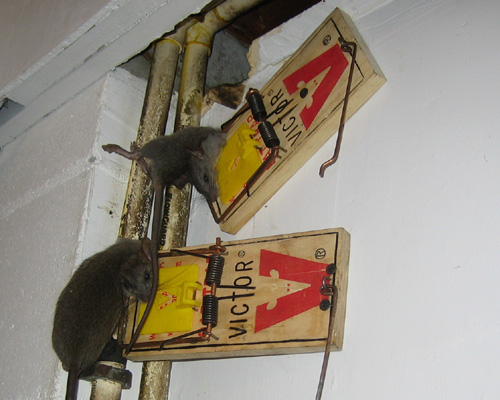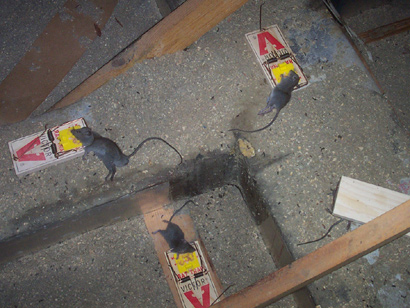- USA Wildlife Removal Education Guide and Resources
How to Get Rid of Rats
HOW DO WE GET RID OF RATS? The key is to inspect every last part of your house, inside and out, find out how the rodents are getting in, and seal those areas shut with non-chewable steel. Repairs are a crucial step in the mouse and rat removal process. In all cases, sealing entry holes shut ensures that no future rodents will ever enter your home.
- STEP 1) Inspect the house, every inch of it, from the ground to the entire roof. Look at all vents, eave gaps, pipe entry, plumbing stacks, and so on.
- STEP 2) Seal every last entry hole with steel repairs, which rats cannot chew through.
- STEP 3) Inspect the attic and find the areas of highest rat activity, marked by droppings, runways, and brown rat grease.
- STEP 4) Set several wooden snap traps on the rat runways. Bait is actually not important.
- STEP 5) Remove rats as they are trapped, and reset the traps. The job is complete once you no longer catch rats, and you no longer hear them scampering in the ceiling.
- STEP 6) If necessary, clean and decontaminate the attic after they are all gone.
- STEP 7) If you still have rats, you failed at step #1. It is not easy.
Rats are animals that can be a major problem when they get into a domestic property, and they will often look to dark and warm areas of the property to make their homes. This means that attic or wall cavities and attic spaces are particularly prone to nesting rats, and it will often be some time before the occupants actually notice the scratching noises or the smell that will suggest a rat infestation. There are a number of health and hygiene issues caused by living in close proximity to rats, and dealing with the problem should be a real priority for those who think they may have rats in their attic or walls.
Identifying The Pest In Your Attic or walls
Although rats and mice are the most common animals that can be found in cavity attic or walls, there are also instances of raccoons and opossums making their way into the cavity attic or wall. The first thing to do is to try and find out how the animals are getting in to the cavity attic or walls, but this will not always be straightforward because access to the attic or wall is not always easy to get. Many people will have to find the holes through which the pests are getting in to the attic or wall, and observing this will often help people to identify the pest. If the rats are using one access to go in and out of your property then it may be possible to trap them without getting in to the attic or wall cavity, but in many situations there will be no choice but to cut into the cavity attic or wall. This should be done above where the scratching noises are being heard, and the cut should only be deep enough to cut the attic or wall, in case the cut goes into any cables running in the cavity. This kind of cutting should really only be undertaken by professionals that have plenty of experience in carrying out this kind of work.
What If You Have Trapped A Rat But Can Still Hear Scratching Noises?
This is a common problem that will happen after trapping a rat successfully, because if the rat has recently given birth then the babies will become more active as they become hungry. In this case there will be no option but to get into the attic or wall and to remove the rats, otherwise they will die, and can cause a significant odor as the bodies decompose. Once again, this is not a job for an amateur, and hiring a professional with experience in the field will mean that they can decontaminate the cavity after all the rats have been removed.
Permanently Excluding Rats From Your Attic or walls
Unfortunately, most rats will operate in much the same way, so if you have had an instance of a rat living in your attic or walls, then getting rid of it will often only be the first step. If you take no action to seal the attic or walls so no other rats can get in, then it is likely that other rats will discover the same entrance into the dark and warm environment within your attic or walls. The most important thing to do is to find out how the rats are actually getting in to the attic or wall cavity itself, and this will often be a difficult task. Rats will often be able to squeeze through holes around an inch in diameter, and any such holes will need to be repaired to ensure that no further rats get into the attic or walls. Although many people will want to be able to deal with all of their household problems by themselves, it will often be the case that dealing with rats in the attic or wall will necessitate calling in a wildlife removal expert.
Go back to the main Rat Removal page for more information about how to get rid of rats.


Rat Information
Biology
Rats are long-tailed rodents that are present in the world in various sizes, colors and shapes. They are larger in size when compared to mice. The two most common types are brown rats and black rats. The brown rats are also known as Norway rats. The black rats are believed to have originated in the Asian regions before slowly making their way to other parts of the world. An adult black rat can be around 30 to 46 cms in length. They are omnivorous in nature and feed on both plants and small insects or animals. They are also very generic in their food and eat about everything they can find. Not only do they feed on fruits, seeds, leaves and stems but also the food stuffs meant for cows, dogs, cats and chickens. They also are a big threat to farmers and destroy agricultural based crops. A Norway rat is around 25 cm in length with a tail that is usually as long as they are. They weigh around 250 to 350 grams. They are known to have originated from China and are an important model of scientific research work. They are able to hear ultrasonic sounds and have a heart rate of around 300 to 400 beats per minute. They have poor eyesight, but unlike other species, they can see ultra violet light as well. Both brown and black rats usually come out during the night time and stay inside their habitat during the day. Both are good swimmers but black rats are also excellent climbers. Brown rats, however, are better diggers. Rats chirp during mating, before receiving morphine or when tickled and can be termed as an expression similar to laughter and is expressed when they are happy.
Rat Habitat
Rats are usually found in areas inhibited by humans. They make their homes in small areas around the building, in homes or in walls which can be easily accessible to them but not to their predators. They are also found in abundance in sewage areas. Good living conditions and availability of food are the two most important conditions they look for while choosing a habitat. They are also found living in areas where there is plenty of vegetation.
Life Cycle
Black rats live for about two years and attain sexual maturity within four months of their birth. During its life, a female gives birth about six times. The number of babies born in a litter varies from five to seven. Spring and autumn are the major breeding seasons. The life span of Norway rats is around three years and the female gives birth to kids about five times in a year. They attain sexual maturity in only five weeks. An interesting thing to know here is that they live in groups and in case there is a scarcity of food, rats who are rated lower in social order die first. Also, if a large portion of either black or Norway rats are killed, they can increase the reproduction rate and return to their original population count.
Carrier of Diseases
Rats are a major cause for a number of different diseases including rat bite fever, Weil's disease, cryptosporidiosis, Q fever, viral hemorrhagic fever (VHF) and Hantavirus pulmonary syndrome. They are also carriers of bacteria responsible for the spread of Justinianic plague and Bubonic plague. The urine, droppings and saliva of rats are responsible for the spread of a number of infectious bacteria. They also contaminate the food, making humans sick.
Problems that they cause to humans
The first and probably the biggest problem they cause is the spread of dangerous diseases. Diseases like the plague have killed millions of people in the past. They also destroy the vegetation and food stored in the house. It is also well-known fact that instead of eating away one full unit of food, they eat a bite from every unit and thus contaminates and destroys the entire resource.


